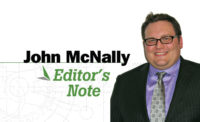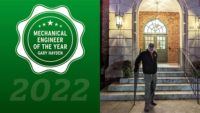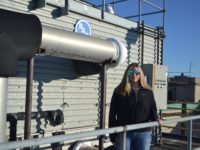Throughout the years in Hollywood, the guidance counselor has received a very unfair rap. Typically, the position is portrayed as a goof that students just roll their eyes at.
For Sarah Balz, her eyes became wide open.
As a high school junior in Athens, Wis., Balz had a pleasant sit-down with Mr. Alwin, who gave Balz the slight nudge to where she is today: an 18-year industry veteran with Madison, Wis.-based Affiliated Engineers who has completed projects all over the world and now has been named pme’s 2014 Plumbing Engineer of the Year.
“Believe it or not, I wanted to be an architect,” Balz says in a conference room at Affiliated Engineers’ office. “That was my dream. My guidance counselor persuaded me to look into engineering. He said, ‘You really excel in math and science. You should really look into engineering.’”
During her studies at the Milwaukee School of Engineering, Balz made it a point of emphasis to confirm that engineering was the career path she wanted to follow. Balz interned with Dairyland Power Cooperative where she performed energy audits. She also interned with plumbing and general contractors.
In the end, Balz found that her guidance counselor was spot on and she was hired by Affiliated Engineers right after graduating from MSOE.
“After a couple jobs in the construction field, I thought I would try engineering first to see if I liked that,” she says, “because I always could go back to contracting.
“I stayed with engineering.”
Lab rat
In 1997, Balz’s first project was the chemistry building at the University of Wisconsin in Madison. The project was essentially four different buildings. There was the construction of a new tower, the renovation of two connected buildings and a new seminar hall.
“It was definitely challenging connecting the buildings together and working in the renovations because it was a bottom-fed building,” she says. “The university wanted to turn it into a top-fed building so that the supply lines for a particular floor were on the floor those lines were serving vs. on the floor below.”
The UW chemistry building was completed in 2000. Currently, Affiliated Engineers is in the midst of working on an addition to the facility, but Balz isn’t the lead on the project because the plumbing is being done by a disadvantaged business enterprise firm.
Balz has completed projects throughout the United States, two in Taiwan, one in Saudi Arabia and one in the United Arab Emirates, but relishes the opportunities to design laboratory projects.
“They are unique,” she states. “The research is always interesting and they’re challenging.”
While she has completed designs for commercial and governmental laboratories, the recent call for Balz’s services are in the educational realm. She says a major reason why the higher education market has increased is because universities are able to spend more on facilities.
“Recently, I have done a lot of university work,” she says. “Usually, the schools need the funding up front and their cycle is slightly behind the economy. Projects happen when funding happens and right now we’re seeing schools having funds.”
Balz also designed projects for the U.S. government, including the Department of Energy’s Natural Renewable Energy Laboratory in Golden, Colo. The scientists at the facility are working on the cutting edge of technology and had a lot of ideas in what they desired from Balz.
“A lot times the users knew what they wanted, but didn’t know how to do it,” she says. “Each lab is unique. It’s not a standard dry or wet lab. They are big open spaces.
“For me, it was trying to design where the piping needs to be and how to get there with the limitations of the facility. We worked with programmers and the users to try to get a layout that would work for them, but it had to be flexible enough for all their different needs.”
Just down the road from Balz’s office in Madison, she designed a “3-Ag” research safety facility for agricultural animals with level three biosafety measures. That facility is essentially doing research in a concrete bunker, she says. There are submarine doors employees come in and out of that use compressed air, and the water system has a lot of backflow prevention.
“Whatever comes in can’t come back out,” she reports. “And if the water does come out it has to go down the drain and be treated. That’s usually through heat sterilization. That is a tried-and-true method.”
Comfortable surroundings
Balz – who has completed seven marathons – works with a team at Affiliated Engineers. The size of her team varies depending on the size of the project and what may go into the specific design. She says Affiliated Engineers provides her the autonomy to chase down any ideas or new design methods that may be a fit for a project she’s in charge of.
“The company is innovative,” she states. “They always are willing to look into something new or some new technology within reason. There has to be sound engineering behind it and if there is, the company is willing to support you.”
Balz and her colleagues are stationed upstairs at the company’s LEED-certified office and she’ll lean on them when needed.
“It is so nice and refreshing to be able to bounce ideas off of them, especially when you get stuck,” she states. “It’s easy to go up to them and ask for help and they’ll come up with something you never thought of.”
Affiliated Engineers holds peer reviews or quiz bowls as they are affectionately called around the office. An engineer will present his or her design during the schematic phase to fellow engineers and then rapid-fire questions are asked.
“They’ll ask, ‘Did you remember this?’ It is sort of a show me quiz bowl,” Balz says. “’Did you specify this?’”
Balz recalls when she was working on a high-rise project with three pressure zones. She had designed separate heating zones to ease the problems of adding energy back in to get the water properly balanced.
She recalls: “Someone spoke up and said, ‘Why don’t you just have one heating system sized for the entire top zone and then have a heat exchanger loop off for your other pressure zones?’”
For Balz, the light clicked on immediately.
“I was like, ‘Oh yeah, that’ll work!’”
Affiliated Engineers Principal Mike Broge, who has worked with Balz since 2000, knows how valuable an asset she is to a company with 14 offices and 578 employees, including 225 in Madison.
“Number one, she’s really smart and she knows what she is doing. Technically, she is at the top of her class,” he says. “Complimenting that, she’s is very good working with people. Those are the two biggest things you can ask for in this industry.”
Broge says her involvement in ASPE has paid off for Balz and Affiliated Engineers. Working with the industry group, according to Broge, has raised Balz’s confidence and others take notice.
“It gives you a lot of credibility in the marketplace,” he says of working heavily with ASPE. “When you’re exposing that confidence in a leadership role you’re proving it to yourself and colleagues. And that word gets out to institutions. Someone has a problem and will say, ‘I was at an ASPE meeting and Sarah said this. I should call her because she’s going to know exactly how to deal with that situation.’”
True passion
Throughout her career, Balz has been a passionate advocate for water conservation.
“Well before LEED came about, we were looking at ways to reduce water consumption or reuse,” she says.
Until recently, water conservation elements such as a rainwater harvesting applications were usually the first things building owners would remove them from the final project. Today, Balz notes water-saving elements – especially rainwater and graywater harvesting – remain throughout construction.
“I’ve been seeing a trend where about one-quarter of these stay in the project,” she says. “That is an improvement from the early 2000s when they would be value-engineered out.”
Balz notes that designing a rainwater harvesting system today is significantly more interesting and a little easier since there are more black boxes available for use. These products help Balz and Affiliated Engineers because they don’t have to think about every piece of the system. Balz can describe the quality of water that comes into the system and the needed quality coming out. The manufacturer will help put the parts together and test the systems.
“That gives us a little peace of mind and usually the manufacturer will service the component or the box,” she says. “It’s nice to know you can work with manufacturers to have what you need and they’ve got a box that will do it for you.”
Balz and her Affiliated Engineers colleagues, at times, have sat down with manufacturers to create or modify products that go into laboratory designs.
“We have been able to work with manufacturers to help initiate reduction in water,” she says.
Balz believes there is vast untapped potential for water savings in laboratory applications.
“We’re helping to push lower-flow lab fixtures,” she says. “As soon as we hear of a new technology we have been very willing to educate our clients about it. Some are not aware of the water savings that they could produce in the labs – new and old.”
Getting clients to commit to these new methods can be tricky, but Balz is a promoter for saving water resources when and wherever possible.
“We bring up the subject and say, ‘We now know this manufacturer is creating this option,’” she says. “For instance, in cooling-coil condensate for a coolant vs. quench cool. (Quench cool) is just dumping a large volume of water to cool a small volume of water. It’s just appealing to common sense.
“I can’t even recall the last time I did a bulk sterilizer with quench cool. I probably haven’t done one since before 2005.”
In the end, it usually comes down to dollars and cents.
“We can show them they may take an energy penalty here, but you’ll receive a large water and sewer savings there,” Balz says.
Fully invested
Balz has been an ASPE member since 1997 and appreciates all the networking she can do at the group’s meetings and conferences. She serves on the U.S. Tag Iso 282 committee and will be a featured speaker at the 2014 ASPE Convention and Exposition in Chicago. She will present on plumbing for LEED v3 to v4.
She spoke at the 2013 ASPE Technical Symposium in Orlando, Fla., and was appreciative of the response after the speech.
“It was interesting to get feedback from what other people had done in the LEED realm,” she says.
Balz has been thankful and fortunate to work on such a broad spectrum of projects that there isn’t one specific application she desires to complete before retirement.
“I have done so much,” Balz says.






